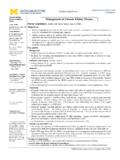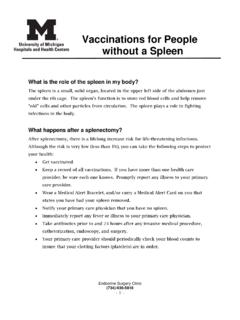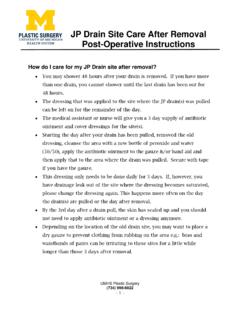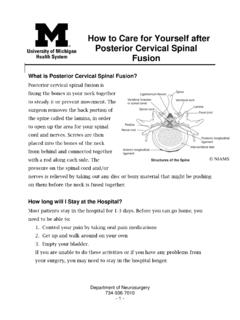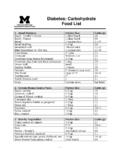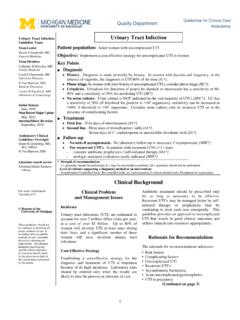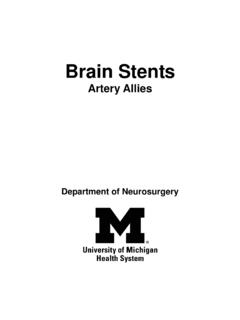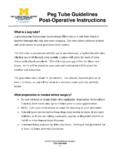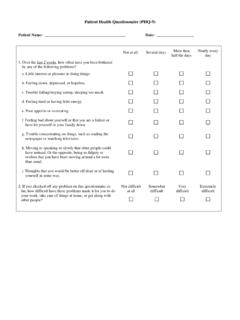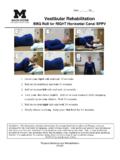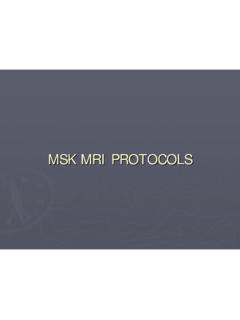Transcription of GUIDELINES FOR TREATMENT OF BONE AND JOINT …
1 GUIDELINES FOR TREATMENT OF bone AND JOINT INFECTIONS IN ADULTS Hematogenous Osteomyelitis Vertebral Osteomyelitis Septic Arthritis Pelvic Osteomyelitis Associated with Chronic Decubitus Ulcers Diabetic Foot Ulcers with Osteomyelitis Prosthetic JOINT Infections Osteomyelitis following Trauma and/or Orthopedic Procedures References Antimicrobial Subcommittee Approval: 06/2016 Originated: 06/2016 P&T Approval: 07/2016 Last Revised: 03/2021 Revision History: 02/2021: Added fungi, mycobacteria, and Actinomyces comment 03/2021: Updated vancomycin dosing & hyperlinks 09/2021: Updated vancomycin infusion reaction terminology The recommendations in this guide are meant to serve as TREATMENT GUIDELINES for use at Michigan Medicine facilities.
2 If you are an individual experiencing a medical emergency, call 911 immediately. These GUIDELINES should not replace a provider s professional medical advice based on clinical judgment, or be used in lieu of an Infectious Diseases consultation when necessary. As a result of ongoing research, practice GUIDELINES may from time to time change. The authors of these GUIDELINES have made all attempts to ensure the accuracy based on current information, however, due to ongoing research, users of these GUIDELINES are strongly encouraged to confirm the information contained within them through an independent source.
3 If obtained from a source other than , please visit the webpage for the most up-to-date document. Table of Contents Page 2 of 8 Hematogenous Osteomyelitis Clinical Setting Empiric Therapy Duration Comments Usually associated with: Patients under age 17 years or over 50 years (recommendations intended for adults only) IV drug use Other risk for bacteremia , central line, dialysis, sickle cell disease, urethral catheterization, UTI Bacterial Etiology: S. aureus 30% Gram negative bacilli (consider if fresh water exposure, recent broad spectrum antibiotics in the prior 90 days, recent >2 days hospitalized in prior 90 days, or hemodynamic instability) Salmonella in sickle cell disease Serratia and Pseudomonas spp.
4 In IVDU Consider holding antibiotics until deep tissue cultures can be obtained in hemodynamically stable patients Preferred: Vancomycin* IV (see nomogram) If known MSSA colonization or infection: Cefazolin* 2 g IV q8h Alternative for vancomycin allergy (not vancomycin infusion reaction**): Daptomycin* 6 mg/kg IV daily If Sickle Cell disease: Vancomycin* IV (see nomogram) + Ceftriaxone 2 g IV daily If IVDU or other Gram negative risk (see bacterial etiology): Vancomycin* IV (see nomogram) + Piperacillin-tazobactam g IV q6h Alternative for patient with mild penicillin allergy: Vancomycin* IV (see nomogram) + Cefepime 2 g IV q8h Alternative for patients with life-threatening penicillin allergy: Vancomycin* IV (see nomogram) + Aztreonam 2 g IV q8h 4-6 weeks Approximately 45% of S.
5 Aureus at UMHS are MRSA, so initial TREATMENT to cover MRSA is warranted. De-escalate to a beta-lactam if methicillin-susceptible S. aureus (MSSA) is identified. Infectious Diseases Consultation recommended. Daptomycin requires prior approval. Baseline CK followed by weekly CK should be measured in patients placed on daptomycin due to increased risk of rhabdomyolysis. Increased dose of daptomycin may be indicated with documented MRSA bacteremia. Infections due to fungi, mycobacteria, or Actinomyces require longer durations of therapy consult appropriate national GUIDELINES for guidance.
6 * Adjust dose based on renal function; vancomycin dose may require adjustment for select organisms or patients Target vancomycin AUC 400-600 mcg*hr/mL Table of Contents Page 3 of 8 Vertebral Osteomyelitis Clinical Setting Empiric Therapy Duration Comments Usually hematogenous source Persons at risk: Age >60 years IVDU Urinary tract infections Bacterial Etiology: S. aureus Occ. Coagulase negative staphylococcus Enteric Gram negatives Pseudomonas in IVDU or water exposure Consider holding antibiotics until deep tissue cultures can be obtained in hemodynamically stable patients Preferred: Vancomycin* IV (see nomogram) + Ceftriaxone 2 g IV q12h If known MSSA colonization or infection: Oxacillin 2 g IV q4h Alternative for suspected or documented Pseudomonal infection (see bacterial etiology): Vancomycin* IV (see nomogram) + Cefepime* 2 g IV q8h Alternative for severe penicillin allergy.
7 Vancomycin* IV (see nomogram) + Aztreonam* 2 g IV q6h Alternative for vancomycin allergy or intolerance (not vancomycin infusion reaction**): Linezolid 600 mg PO/IV q12h + other antibiotic as indicated above Minimum 6 weeks Evaluation for epidural infection is critical. See full Vertebral Osteomyelitis FGP Guideline Infectious Diseases consultation strongly recommended. Step down therapy to oral antibiotic usually indicated after 6 weeks of therapy. Approximately 45% of S. aureus at UMHS are MRSA, so initial TREATMENT to cover MRSA is warranted. De-escalate to a beta-lactam if methicillin-susceptible S.
8 Aureus (MSSA) is identified. Cefazolin may replace oxacillin, if no epidural extension of infection is present. Linezolid requires prior approval. Baseline CBCP and weekly CBCP are recommended with linezolid therapy due to risk of cytopenia, especially thrombocytopenia; alternative therapy should be considered in patients with thrombocytopenia. Linezolid should be used with caution in patients on medications with serotonergic activity, , SSRI and MAOI. See SSRI & Linezolid Education. Daptomycin may replace linezolid if no epidural extension of infection is present.
9 Empiric dosing takes into account epidural abscess with possible CNS extension. Infections due to fungi, mycobacteria, or Actinomyces require longer durations of therapy consult appropriate national GUIDELINES for guidance. * Adjust dose based on renal function; vancomycin dose may require adjustment for select organisms or patients Target vancomycin AUC 400-600 mcg*hr/mL Table of Contents Page 4 of 8 Septic Arthritis Clinical Setting Empiric Therapy Duration Comments Usually associated with: Age >80 years Diabetes mellitus Rheumatoid arthritis Prosthetic JOINT Recent JOINT surgery Skin infection IV drug abuse Alcoholism Prior intra-articular steroid injection Bacterial Etiology: S.
10 Aureus Streptococcal species, including S. pneumoniae Gram negative bacilli associated with trauma, intravenous drug users, older adults, and in association with underlying immunosuppression. N. gonorrhea in oligoarthritis, (particularly young, sexually active), associated tenosynovitis, vesicular pustules, late complement deficiency, negative synovial fluid culture and Gram stain Consider holding antibiotics until deep tissue cultures can be obtained in hemodynamically stable patients Preferred: Vancomycin* IV (see nomogram) If known MSSA colonization or infection: Cefazolin* 2 g IV q8h Alternative for vancomycin allergy (not vancomycin infusion reaction**): Linezolid 600 mg PO/IV q12h OR Daptomycin* 6 mg/kg IV daily If risk for gonorrhea.
